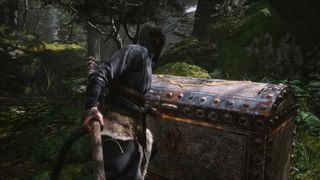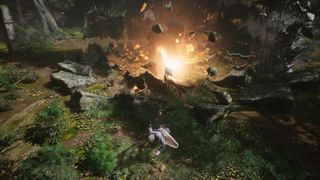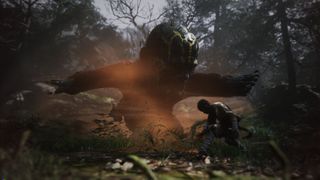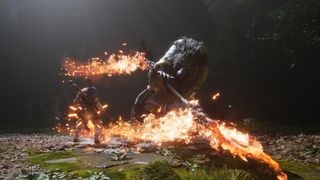If you can look beyond some janky fights and want to experience a unique setting, there’s fun to be had in Black Myth: Wukong.
Pros
- +
Visually superb backdrops
- +
A unique setting
- +
Some fun spells enhance combat
Cons
- –
Bosses are a mixed-rate overabundance
- –
At times detail makes navigation unclear without a map
Why you can trust TechRadar We spend hours testing every product or service we review, so you can be sure you’re buying the best. Find out more about how we test.
Review info
Platform reviewed: PC
Available on: PC, PS5, Xbox Series X, Xbox Series S
Release date: August 20 (TBC for Xbox)
Chinese games are increasingly making a name for themselves on a global scale, although their impact beyond domestic borders has been mostly limited to the free-to-play scene through titles heavily influenced by Japanese anime. This is in part reflective of tastes within the Chinese market generally, a sector dominated by PC, mobile and free-to-play gaming, although as a result of this divergence in tastes it has made it difficult for titles beyond those like Hoyoverse’s Genshin Impact to resonate internationally. Could Black Myth: Wukong change all that?
It’s difficult to say. While the game has certainly captured imaginations pre-release for its richly-detailed worlds inspired by historical China and Journey to the West, even as it has dealt with controversy over its sexist and misogynistic remarks against female players, from a gameplay perspective the final experience is one that feels lacking in numerous key areas. While it certainly looks capable of standing toe-to-toe with the biggest Western AAA titles of the moment, actually sitting down with the game is a different story.
Although no means without merit, this is a game that is screaming for more polish and refinement in its moment-to-moment gameplay. Instead of feeling truly immersed in this journey through classical China, every strength the game had is compounded and diluted by a plethora of other issues that accumulated in a frustrating case of form over function.
Mythol-ouch-ical

Playing as the Destined One, you face various Yaoguai that roam this mythical world, exploring everywhere from barren desert-like landscapes to towering mountains and dense forests as you face and harness the powers of Chinese mythological beings and enact revenge. The journey of the novel which inspired it has been adapted cross-culturally and across every medium for centuries, so it should come as no surprise that the tale of revenge and into new worlds feels right at home in a game. It’s perfect subject matter for adaptation, although in this case its adaptation is surprisingly lacking in story and character.
Narrative is certainly not the focus here. Mythological beings both friend or foe rarely feature for more than a single-scene cameo, and without deep prior knowledge of Chinese myth, the fact each is meticulously recreated from Chinese legend means little. The game barely builds these beings to feel as omnipotent or powerful as they really are; a surprising choice when emphasizing their status would certainly have elevated the stakes of some battles. Journey to the West tales are dominated by the joys of the characters accompanying Son Wukong, and with creatures of myth barely more than an obstacle for a single boss fight before being forgotten and without a companion by your side, this is stripped for something solitary and unfortunately cold.
Best bit

Although the fights themselves are a mixed bag, the boss designs are a consistent treat, taking their cues from Chinese mythology but imbuing it with a new perspective on a classic tale.
Worse, this lack of character and lack of true introduction to any mythological being we fight robs the game of drive or a clear end goal, and it often feels aimless as you wander through environments unsure what the point is of continuing on our path. It feels unbalanced, an issue which permeates much of the game far beyond its lacking story.
Although often described as a soulslike adventure, this is much more of a typical action adventure in the realm of titles like Bayonetta in terms of action (albeit with a staff as your solitary weapon of choice). A few familiar mechanics pioneered by Dark Souls have clearly influenced and been integrated into the title: your flask in this instance is a gourd you consume in the heat of battle to restore your health.
Still, this is otherwise a traditional action title, fast-paced and combo-driven without the deliberately-laborious nature of uninterrupted animations that allows for more reaction-based action and freedom. A well-timed dodge and a good counter means more, but learning a boss’ strategy is similarly key to victory – button mashing won’t be enough.
Yet it is possible to have too much of a good thing, and the impact of overcoming a boss fight is lost when your game is little more than a 30-40 hour boss gauntlet. For all the world is visually impressive at a glance, it soon becomes clear that much of its beauty is mere set dressing, as we continue through a railroaded corridor with little room for deviation from the path for much of our adventure. In the moments where players could diverge from the path, it felt almost discouraged due to the game’s baffling lack of a map, often leaving me lost on where to go next or fighting waves of enemies thinking I found the answer, only to reach a dead end.
Then again, even if we did have a map, it would simply emphasize how little time we have to adore the stunning scenery. It’s only by getting lost that there’s time to appreciate these environments, as you otherwise spend little more than a minute or two walking through a few brief corridors before being thrust into yet-another battle arena for a mini-boss or major opponent. Boss fights are an overabundance to the point of robbing us of exploration and puzzles, with many chapters hitting double-figures and throwing them at you in such frequency they merge into an amorphous blob where few are memorable by the time the credits roll.
Boss Myth: Wukong

The bosses that do stick out in my memory unfortunately do so for the wrong reasons. A lack of polish in some fights leaves them feeling unfair, especially when it comes to the game’s numerous optional side-bosses. In the Black Bear Guai fight I felt I finally turned a corner in my struggles to overcome this boss as I understood his pattern of abilities. As he jumped in the air, I moved out of the way of his momentum, sure I would dodge, only for him to contort his momentum to my new location in a way that would seem impossible considering his movement and trajectory.
In a fight against the electrical Tiger Vanguard I would find it difficult to dodge his attacks without reaching higher ground on rocks placed inside the arena. Yet it would also be possible for him to destroy these platforms and leave no solace from his attacks, often causing my inevitable demise in a manner that felt undeserved.

In cases where these boss fights don’t feel unpolished, they simply lacked an excitement or edge to make them feel anything more than average. It’s an unfortunate summary for much of the game. There’s little here that will offend, and indeed it’s easy to find joy in aspects of Black Myth: Wukong’s world, visuals and combo-driven action. One of the major factors that got me through the game to its end was how refreshing it felt to see this Chinese setting come to life, bringing to life a world and mythology so rarely portrayed and explored in the medium despite the rich tapestry any game in this setting can explore. At times the way this culture is brought to life left me slack-jawed in awe.
At others I’m merely left frustrated. It’s a lack of polish and time that makes this a game difficult to recommend without numerous caveats. The groundwork for greatness is here. With fewer, more refined boss fights, more expansive environments accompanied by a map to help players when they’re lost, and a bit more story to give the whole adventure direction and purpose, I truly believe there is potential for something special in Game Science’s next project provided the lessons from this experience are internalized.
As things stand, I’m reminded of a nostalgic era of PS2 AA action titles with exceptionally high levels of polish and that’s no bad thing! These were not always the most refined games in the world, often lacking a spark to elevate them into the realm of greatness, but there was always fun to be had in such experiences. I expected more, and don’t think I’m alone in this.
Accessibility
The game is mostly lacking in accessibility settings, with controls unable to be customized except when using keyboard and mouse, though it does offer a colorblind mode. Subtitles are available for dialogue, but text is small, difficult to read in many circumstances, and can’t be altered.
Should I play Black Myth: Wukong?
Play it if…
The game is full of major fights and spectacle, so if that’s what you seek you won’t be disappointed.
Don’t play it if…
There’s joy to be found in what is here, but you have to overcome the game’s quirks to find that fun and strategy.